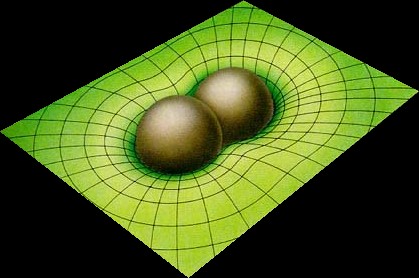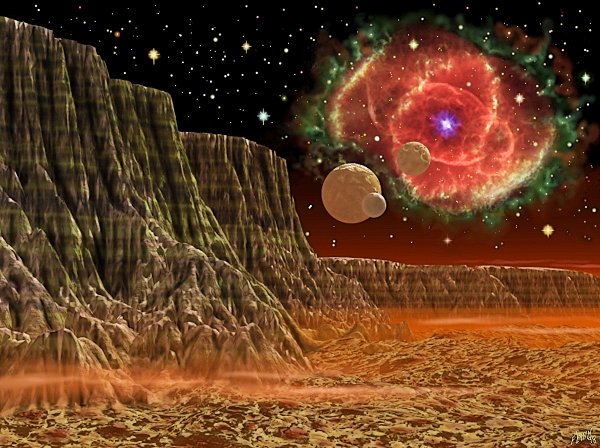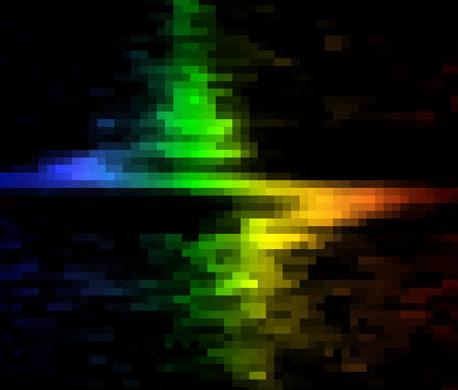|
Does Vacuum Exist ?
How Many Dimensions Does Energy Have ?
How Can We Curve Space ?
How Can We Curve Time ?
An Eye Can Not See Itself - The I Principle
Higher Dimensional Physics & Fime

Does Vacuum Exist ?
Let's consider the following logical sequence :
If something, for example a car, which has a certain mass, is parked in the garage, it is occupying
a space. This space is defined by the three dimensions length, width
and depth.
If the car is moved from the previously mentioned space, that space should be occupied
by somethimg else, for example air. This air has the same dimensions as
the car had.
If something is not occupieng that space then it should
be nothingness.
Nothingness, by definition, has neither length, width
nor depth.
|
Then if there is space, that's to say length, width
and depth, there should be something occupying
that space.
|
|
If that is a law then vacuum does not exist, because it occupies space.
|
If vacuum does not exist then there should be something that
exists in its space, a something that we can not detect by
our technology.
Let's speculate and say that it is
aether (is it the dark matter of the universe?)
which scientists try to detect.
If aether does exist then it can "acquire" infinite shapes in the space.
The above conclusions about mass should be combined with the next ones about energy.
Up


How Many Dimensions Does Energy Have ?
If we look at Einstein's equation E=mc², and if we try to
look at the equation from a qualitative point if view by assigning dimensions
to the equation, we will deduce the following
"Dimensional Relationship of Energy":
Energy = Mass x (The Speed of Light)²
If we express the mass and the speed of light in dimensions then
Energy Dimensions = Length x Width x Depth x ( Length / Time )² or
Energy Dimensions = Dimension x Dimension x Dimension x ( Dimension / Dimension )²
If anything devided by itself results in 1 then
Energy Dimensions = Dimension x Dimension x Dimension x ( 1 )² or
Energy Dimensions = Dimension x Dimension x Dimension or
|
Energy Dimensions = Dimension³
|
The above conclusions should be combined with the previous ones about mass.
That results in the following.
Up

How Can We Curve Space ?
|
From the above two sets of conclusions we can deduce that space is no more than the "expression" of the
mass and energy. This is probably why the space can be bent.
The presence of something filling the
vacuum would
make life easier in this context.
|
But how time
can be bent?
Up
How Can We Curve Time ?
Let's analyze the difference between a photo and a movie as a five year old
child does. Julia answers the following when she is confronted by that
question:
- A photo is movements frozen in time.
Thank you Julia, but what is time? Julia looks at a clock on the wall and says:
- It is the movement of the clock.
Julia has associtaed time with motion twice.
If we think about these answers and try to develop that concept by
comparing a photo to a movie, we will
find that a movie is full of life because it brings a large number
of multiple lifeless frames into motion, and hence giving us the feeling
of the passage of the time in the movie versus the lifeless image of a photo.
|
The association of time with motion seems to be very significant and
crucial in the understanding of the nature of time. It is very difficult to
imagine that we could measure time if the sand grains
of an hourglass did not fall, the mechanism of the clock did not move etc..
Without motion time could neither be felt nor measured.
Hence time is an "expression" of motion.
But motion in nature does not follow a straight line. So, there
should not be any contradiction in the statement that time, which is
the "expression" of motion can be bent.
|
3D Clock by Bennet
Up

© 1998 Marilynn Flynn
The painting shows "Cat’s Eye Nebula", NGC 6543, as seen by Hubble Space Telescope.
The added planet in this scene shows the effects of having had its surface and atmosphere
blasted
by the exploding stars.
An Eye Can Not See Itself
By combining the above two concepts, that's to say space as the
"expression" of the mass and energy, and time as the "expression"
of motion, we can reach the following conclusions:
1. Space is the impression that we get by observing the different interrelations
of mass and energy which are present around and within us.2. Time is the
impression that we get by observing the relative motion of mass and energy.
3. We can not and we will not be able to comprehend the real nature
of matter, energy, the three dimensions of space,
the fourth dimension time and the other potential dimensions, such as fime, we are only able to define their effects
but not their true nature.
We are made up of these concepts and we are integrated into them.
We are like an eye which can not see itself. It can see
other eyes and it can see its reflection in the mirror, but it can in no circumstances
see itself, never ever.
This principle could be called "The I Principle";
I=Incomprehension or I=Eye.
|
Up
Higher Dimensional Physics & Fime
Dimensions, including the three dimensions of space and the temporal
dimension time can not be considered as physical entities as such, but rather
the "Relationship Fabric" that reflects the expression of the fabric of
the mass and energy. Such definition does provide the ground for the existence
of other dimensions, higher dimensions or hyperspace. The concept
of higher dimensions emerged in the
middle of the 19th century, and it gained new life toward the
end of the 20th century.
|
Fime Theory presents the fifth dimension, Fime, as the
temporal or chronological dimension which contributes with time and space to the
interrelations of the mass-energy fabric of our universe.
|
Up

Sumerians & Time
|









